We need your consent to use the individual data so that you can see information about your interests, among other things. Click "OK" to give your consent.
ASTM B579-73(2015)
Standard Specification for Electrodeposited Coatings of Tin-Lead Alloy (Solder Plate)
STANDARD published on 1.3.2015
The information about the standard:
Designation standards: ASTM B579-73(2015)
Note: WITHDRAWN
Publication date standards: 1.3.2015
SKU: NS-585702
The number of pages: 5
Approximate weight : 15 g (0.03 lbs)
Country: American technical standard
Category: Technical standards ASTM
The category - similar standards:
Annotation of standard text ASTM B579-73(2015) :
Keywords:
electrodeposited coatings, tin-lead alloy (solder plate), solder, tin-lead alloy, tin-lead ,, ICS Number Code 25.220.40 (Metallic coatings)
Additional information
| 1. Scope | ||||||||||||||||||||||||||
|
1.1 This specification covers the requirements for electrodeposited tin-lead coatings on fabricated articles of iron, steel, copper, and copper alloys, to protect them against corrosion (Note 1), to improve and preserve solderability over long periods of storage, and to improve anti-galling characteristics. Note 1: Some corrosion of tin-lead coatings may be expected in
outdoor exposure. In normal indoor exposure, tin-lead is protective
on iron, copper, and copper alloys. Corrosion may be expected at
discontinuities (pits or pores) in the coating. Porosity decreases
as the thickness is increased. A primary use of the tin-lead
coating (solder) is with the printed circuit industry as a
solderable coating and as an etch mask material.
1.2 This specification applies to electrodeposited coatings containing a minimum of 50 % and a maximum of 70 % tin. The specification applies to mat, bright, and flow-brightened tin-lead coatings. Note 2: Tin-lead plating baths are composed of tin and lead
fluoborates and of addition agents to promote stability. The final
appearance may be influenced by the addition of proprietary
brighteners. Without brighteners, the coatings are mat; with
brighteners, they are semibright or bright. Flow-brightened
coatings are obtained by heating mat coatings to above the melting
point of tin-lead for a few seconds and then quenching; palm oil,
hydrogenated oils, or fats are used as a heat-transfer medium at a
temperature of 260 ± 10°C (500 ± 20°F), but other methods of
heating are also in use. The maximum thickness for flow-brightening
is about 7.5 μm (0.3 mil); thicker coatings tend to reflow
unevenly. The shape of the part is also a factor; flat surfaces
tend to reflow more unevenly than wires or rounded shapes
(Note 3).
Note 3: Volatile impurities in tin-lead coatings will cause
bubbling and foaming during flow-brightening resulting in voids and
roughness. The impurities can arise from plating solution addition
agents and from improper rinsing and processing.
1.3 This specification does not apply to sheet, strip, or wire in the unfabricated form or to threaded articles having basic major diameters up to and including 19 mm (0.75 in.). |
||||||||||||||||||||||||||
| 2. Referenced Documents | ||||||||||||||||||||||||||
|
Similar standards:
Historical
1.11.2014
Historical
15.5.2013
Historical
1.11.2014
Historical
1.11.2010
Historical
1.12.2013
Historical
1.3.2015
We recommend:
Technical standards updating
Do you want to make sure you use only the valid technical standards?
We can offer you a solution which will provide you a monthly overview concerning the updating of standards which you use.
Would you like to know more? Look at this page.


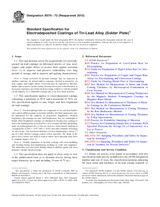
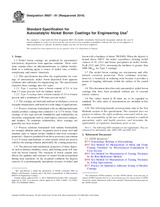 ASTM B607-91(2014)..
ASTM B607-91(2014)..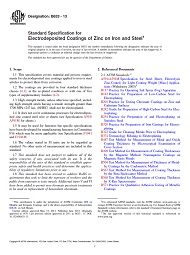 ASTM B633-13
ASTM B633-13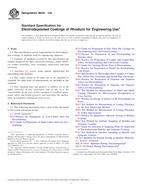 ASTM B634-14a
ASTM B634-14a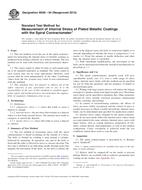 ASTM B636-84(2010)..
ASTM B636-84(2010)..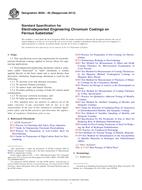 ASTM B650-95(2013)..
ASTM B650-95(2013)..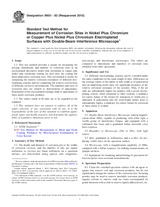 ASTM B651-83(2015)..
ASTM B651-83(2015)..
 Cookies
Cookies
